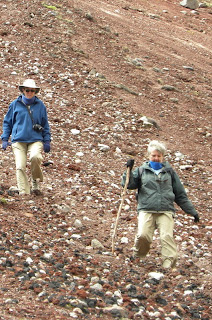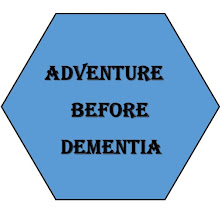First the road took us through one of the world's largest man-made forests, mile after mile of Pinus radiata, a California pine related to the Monterrey Pine. This species was the "winner" of the tree-growing experiment and today is widely planted for timber; it matures in about 30 years. New Zealand produces about 12 million tons of timber per year from manmade forest.
We also passed through more green rolling hills; these were mostly sheep farms.
We stopped in a parking area near the base of the volcano, where we were met by two scruffy characters in a four-wheel drive bus. Charley, pictured here, was to be our guide - and stand-up comedian.

The bus brought us through the bush to about 3000 feet; we had only to climb the final 1000 feet to the rim - and then to descend into the crater and climb out the other end. It sure does look like a long way down.
The descent into the crater was a lesson in walking through scree down a very steep hill; scree is marble-size pieces of lava rock that slip, slide and roll with every step. The trick was to walk heel first and lean backwards a bit. Who would have thought that getting to the bottom would be such an adventure?
The climb out was a bit more strenous, requiring a couple of stops to take in the view (and catch one's breath). Note also that coats, gloves, etc., have been shed.
Back out on the rim, we posed for more pictures before heading back to town for lunch and a walk around the central part of Rotorua.
In mid-afternoon, we went to the New Zealand Maori Arts and Crafts Institute, known as Te Puia (Our Heritage). This is New Zealand's first cultural tourist attraction, and the Maori in this area are famed for their performing arts. Te Puia encompasses a large thermal area with geysers, steam vents, fumaroles, and mud pots. There also are exhibits, a kiwi house, carving and weaving schools, and a recreated Maori village and meeting hall. Our guided tour started with an overview of the Maori people and their culture.
Our first stop was for tea - there was a tent set up and the chef was waiting for us. He cooked corn on the cob, prawns, and green-lipped mussels in a 'cooking pool,' a boiling hot natural pool. There was also bread and assorted dips/sauces, and other goodies - plus kiwi juice, wine and beer. This was not your ordinary afternoon tea!
One of the most common shrubs in the park is the Manuka bush, or New Zealand Tea Tree. Tea can be made from the leaves of this plant, but its real fame comes from the honey made from its flowers. Manuka honey is said to possess unsurpassed healing powers - curing a wide range of conditions from infections to stomach ulcers. We can't attest to all of that, but we can report that Manuka honey tastes great in a nice cup of hot tea.
Well-fortified with food and drink, we set out to see the thermal features of the park. The main attraction is the Pohutu Geyser, which is the largest geyser in the Southern Hemisphere. When it is in full eruption, it reaches nearly 30 meters in height.
One of our favorites was the mud pool - large and small pools of boiling mud - fun to watch and to listen. This mud pool is just below our hotel window, with the Pohutu Geyser just behind it.
At the Kiwi House, we learned about the endangered status of New Zealand's national symbol. Since it is unable to fly, it is easy prey for all manner of predators. We knew that New Zealanders are generally known as Kiwis, but now we learned that the nickname didn't derive from the bird, but from the shoe polish. In World War II, New Zealand soldier carried a tin of Kiwi shoe polish that was greatly prized by other soldiers. Soldiers from other countries would trade for Kiwi shoe polish and began calling the NZ soldiers "Kiwis."
At the carving school, we saw some of the students' work and heard about the three-year program of study with master carvers.
At the weaving school, we saw some of the many products of weaving - clothing, mats, baskets, rope - all made from the flax plant.
After a stop at the obligatory gift shop, we assembled at the gateway to the beautifully carved Maori meeting house. We were met by fierce warriors who performed a ritualistic challenge and then welcomed into the meeting house for some entertainment. The festivities included singing, dancing, games, and audience participation.
After the festivities, our group headed into a private dining room for a special four-course meal. There was enough food to feed an army – all sorts of local delicacies. We all ate too much, said our goodbyes to our guide, and waddled back to the hotel.
























